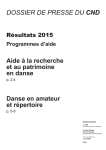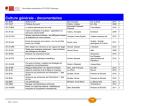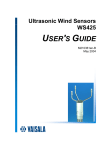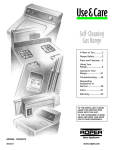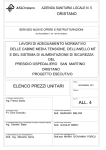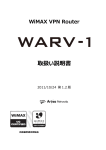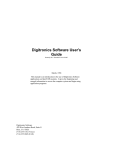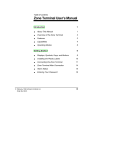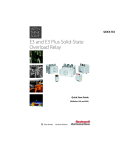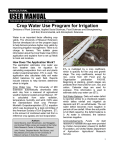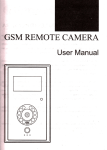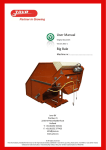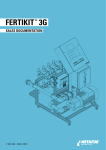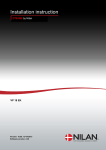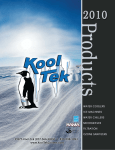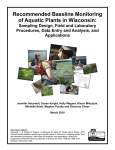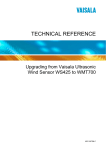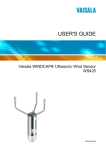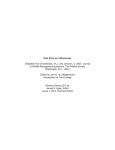Download Monitoring Manual
Transcript
Integrated Waterbird Management and Monitoring Approach for Nonbreeding Waterbirds Monitoring Manual Version 8: February 2015 Scrub-shrub Mallards. Photo Credit: Mick Hanan FWS i INTRODUCTION The Challenge - Sustaining healthy populations of waterbirds that migrate long distances is a major challenge for land managers. How does a manager know which species to manage for at a specific site? How important is a single site in the big picture? How can many managers coordinate their management of impoundments across the landscape so that the birds have the right amount and quality of habitat, at the right time, in the right places? As part of the IWMM approach, managers and scientists are working together to develop integrated monitoring protocols, decision support models, and a database that will inform waterbird management decisions at multiple spatial scales. These products will support clear and transparent decision making processes with respect to waterbird habitat management. The Integrated Waterbird Management and Monitoring (IWMM) approach was initiated by conducting structured decision-making (SDM) workshops to develop an operational framework for management and monitoring of waterfowl, shorebirds, and wading birds, collectively referred to as waterbirds, at the local, regional and flyway spatial scales (Coppen et al. 2007, Laskowski et al. 2008, Lor et al. 2008). Through these workshops IWMM developed a multi-scaled adaptive management process that will inform local, regional/state, and flyway managers about how they can best meet the needs of migrating and wintering waterbird populations. Waterbird needs during the migration and winter phases of their life-cycle are just as critical as those during the breeding season. However, IWMM is the only landscape scale monitoring effort developed to date that tracks and links waterbird habitat use, habitat conditions and management actions during the migration and wintering periods. This approach includes a monitoring component that assesses how well managers at all scales are meeting their management objectives and an adaptive feedback loop that allows managers to adjust their management to address emerging threats. This manual provides survey techniques (i.e. procedures) described herein that involve visual assessments of whole-wetland unit habitat conditions and counts of waterbirds conducted from the perimeter of the wetland unit. A series of standard operating procedures provides greater detail on recommended methods and technical aspects of this protocol, and were used to develop a national protocol framework to guide the local monitoring component of the IWMM approach at units within the National Wildlife Refuge System. Data entry, archival, and multi-scale analysis are handled through an online database that is part of the Avian Knowledge Network. Refer to the following for the complete protocol framework: Loges BW, Tavernia BG, Wilson AM, Stanton JD, Herner-Thogmartin JH, Casey J, Coluccy JM, Coppen JL, Hanan M, Heglund PJ, Jacobi SK, Jones T, Knutson MG, Koch KE, Lonsdorf EV, Laskowski HP, Lor SK, Lyons JE, Seamans ME, Stanton W, Winn B, and Ziemba LC. 2014. National protocol framework for the inventory and monitoring of nonbreeding waterbirds and their habitats, an Integrated Waterbird Management and Monitoring Initiative (IWMM) approach. Natural Resources Program Center, Fort Collins, CO. This protocol is available from ServCat: [http://ecos.fws.gov/ServCatFiles/Reference/Holding/40340] 2 Why Monitor Waterbirds and their Habitats? We anticipate that setting and obtaining local management objectives will require knowledge about waterbird use, setting habitat condition objectives, the ability to assess the efficacy of management actions (e.g. accounting for management costs in terms of use-days or supported populations), and / or the ability to learn how to improve management (Lyons et al. 2008). Also, depending on the management objective, the survey activity will often entail assessing status and trends of habitat conditions or waterbird numbers. Resulting data may be used to calculate wetland unit-specific waterbird use-days, document migration chronologies, and explore relationships between waterbird counts, management actions and habitat condition. Survey Units A survey unit is a single managed or unmanaged wetland unit. Boundaries of the unit should be fixed throughout the season and across years to ensure data comparability. See Standard Operating Procedure (SOP 1). Site, survey unit, and observer codes will be assigned by IWMM staff to ensure that they do not duplicate codes in use by other cooperators. Please contact the Science Coordinator ([email protected]) for assistance in assigning codes. If you do not know the codes, please leave them blank, but make sure that you fill in name details so that the codes can be completed subsequently. Please refer to SOPs 2 - 5 for additional information regarding pre-survey logistics and preparation, including equipment needed for waterbird and vegetation surveys. Survey timing and schedule Waterbird and unit condition surveys are completed weekly or biweekly during the non-breeding waterbird season. See SOP 2. 3 Figure 1. Generalized annual schedule for the Midwest for implementing waterfowl surveys, vegetation surveys, data entry, and reporting. Flexibility in assigning start and end dates for key tasks has been retained to facilitate customization of site-specific protocols. A practical approach for selecting survey dates during the non-breeding season is to systematically conduct Waterbird and Unit Condition Surveys on a weekly or biweekly basis. Subjective selection of survey dates should be avoided because it can introduce bias into migration curves and bird use-day estimates. Vegetation surveys are completed once late in the growing season. See SOP 5. Recording Management Activities. In addition to monitoring waterbird use and habitat response, routine short-term habitat management activities from the start of the current year’s growing season to the start of the next year’s growing season will be tracked for each management unit. See SOP 6. Data entry The IWMM will be transitioning to an online database that will be part of the Avian Knowledge Network (AKN). This database will provide centralized data entry and reporting capabilities for IWMM cooperators. As a member of the AKN, IWMM will be able to share data and tools with other members, such as the International Shorebird Survey. Cooperators should enter collected data into the IWMM’s centralized, online database. More specific instructions for entering data into this database can be found in SOP 7. 4 Qualifications All surveys need to be conducted by qualified individuals. Surveyors should be able to: • • • • Identify waterbird species Identify common wetland plant species Estimate numbers of waterbirds using advocated techniques Follow survey protocols Training Cooperators should visit the IWMM website at: http://iwmmprogram.ning.com/ for a 20-minute webinar that will introduce IWMM and its waterbird and vegetation survey methods. This webinar can be found on the Presentations page as IWMM Training Presentation 2012. Updates are presently being made for the 2015 season. Inexperienced waterbird counters are advised to practice their counting and estimation techniques before participating in IWMM. Data collectors should also be trained for dealing with any local hazards and proper procedures for handling and collecting injured or dead wildlife. For instructions on how to handle and submit waterfowl carcasses for cause of death diagnosis, please see Supplemental Materials (SM-8) as well as the Mortality Event Response instructions on the Wildlife Health office internal website: https://sites.google.com/a/fws.gov/fws-wildlife-health/products. Please use the Q&A forum within the website for general methodological queries. Alternatively, use the messaging feature to contact the Science Coordinator. To access the Q&A forum or messaging features, you will need a membership, email [email protected]. Dead birds If carcasses of waterbirds are found, follow the guidelines provided in SM 8. For More Information: o IWMM National Project Coordinator—Linda Wires USFWS, 5600 American Blvd West, Bloomington, MN 55427 [email protected] o IWMM National Science Coordinator—Tim Jones (Interim) USFWS, Merriam Lab, Room 215 11510 American Holly Drive Laurel, MD 20708. [email protected] o Midwest- Brian Loges, Two Rivers National Wildlife Refuge, HC 82 Box 107 Brussels, IL. [email protected] o Southeast & Northeast- John Stanton, U.S. Fish and Wildlife Service, North Carolina Migratory Bird Field Office, 155 L.A. Keiser Drive, Suite A, Columbia, North Carolina 27925. [email protected] 5 SOP 1: Delineating Unit Boundaries Before conducting waterbird and vegetation surveys, follow these instructions to delineate the boundaries of each unit surveyed. Once boundaries are established for a unit those boundaries should remain the same throughout the season and year to year. Equipment GPS Printed aerial images GIS & digital imagery Observers should define survey unit boundaries to accommodate whole-area waterbird counts and vegetation surveys. On managed lands, wetlands are often divided into management units. Wherever possible, existing management units will be used as survey units. A management unit is defined as a fixed area where recurring waterbird management actions are applied. Management actions may vary in type and frequency. Cooperators have the discretion to survey units ranging from intensively managed moist-soil systems to protected natural wetlands with no habitat manipulation. It is expected that the observer will be able to visually assess >70% of the survey/management unit (Figure SOP-1.1). If an observer cannot visually assess >70% of a unit’s area, additional vantage points should be added in lieu of splitting the management unit into multiple survey units. This criterion applies to the surface area of a unit not to the visibility of birds within a unit. While multiple observation points can be established around the perimeter of the unit to meet this criterion, but observers should bear in mind the need to complete the count on the unit within a single morning and to minimize multiple counting of individual birds. Note that the boundaries of the unit should be fixed through the season and across years to ensure data comparability. 6 Figure SOP-1.1. Percentage of survey unit within a whole-area count. In this case, 70% of the unit falls within the whole-area count. Full pool (spillway elevation) levels in managed impoundments or seasonal high water marks in areas with uncontrolled water levels can be used to delineate unit boundaries. Units may include areas above these high-water marks. Observers may use remote sensing resources to identify the boundaries of the wetland basin or GPS permanent topographic or other physical features in the field to define the management unit’s extent. GPS accuracies meeting or exceeding 3–16 feet (1–5 meters) are acceptable (USFWS 2012): Commercial-grade GPS receivers with WAAS enabled (to provide differential correction) should be used. 7 Relatively inexpensive GPS receivers or hand-held (cell phones) devices do not provide the needed 3–16 feet meter accuracy. Position averaging is recommended to meet the accuracy requirement. Metadata should reflect estimated accuracies from field personnel during data collection activities. To facilitate inter-year comparisons of observations, survey unit boundaries should not be altered. Observers should create and maintain printed maps and geospatial layers as aids in maintaining consistent boundaries. Digitized files with identified accuracy, projections, and coordinate systems (ArcGIS shape files or KML files digitized from Google Earth) will be submitted through the on-line database. Please see Figure SOP-1.2 for flow chart that will help guide decisions regarding survey units. Figure SOP-1.2. Decision Flowchart for creating new or modifying existing management unit into IWMM survey units. References [USFWS] U.S. Fish and Wildlife Service. 2012. Data Delivery Standards and Specifications Template. USFWS, Pacific Southwest Region. Sacramento, California. 8 SOP 2: Waterbird and Unit Condition Survey Follow these instructions for preparing and conducting waterbird counts and assessing conditions for each unit at time of survey. Associated data collection sheets can be found in Supplemental Materials 3 and 4. Measurements Counts of waterbirds by species Visibility (%) Wind speed (mph class) Tide position (class) Salinity (ppt) Water depth (cm class) Ice (% cover class) Flood duration (days class) Habitat cover (% of cover class) Interspersion of habitat patches (class) Vegetation height (cm or m class) Waterbird disturbance response (class) Disturbance source (class) Chronic human disturbance (class) Equipment Good optical equipment, including a spotting scope Thermometer (˚F) Refractometer or hydrometer Map of the site and unit boundaries AOU species code sheet (Supplemental Materials 1: alphabetical order or Supplemental Materials 2: taxonomic order) Waterbird Survey Form (Supplemental Materials 3: Single unit and Supplemental Materials 4: multiple units) Survey Schedule Waterbird surveys should ideally be conducted at least once per week during the peak migration periods for waterfowl and shorebirds (See Figure 1: Survey timing and schedule). Estimates of usedays using weekly counts have greater statistical power than those conducted on a biweekly schedule (B. Tavernia, USGS, personal communication). It is best to designate a particular day of the week for the surveys so that they are spaced as evenly as possible. In coastal areas, surveys should be conducted within two hours of high tide to control for the effect of the tidal state of nearby mudflats. At inland sites, the time of a 24 hour period for conducting surveys should be based on the management objective. For example, if a manager is 9 interested in supporting roosting activities, the counts should occur during a period when birds are most likely to be roosting in a site. Flexibility in the timing of surveys is needed to address constraints such as staffing, other activities taking place within units (e.g. hunting or management), and weather. If multiple units are surveyed, it is good practice to change the order of surveys by choosing different starting units on each visit (wherever possible). If count numbers are expected to be compiled, counts for all units should be completed in one day to minimize the interchange of birds across units. Multiple-counting of individual waterbirds should be avoided. If birds regularly flush from units during counts, then efforts to minimize disturbance during surveys or concurrent surveys may be needed to minimize the multiple-counting of birds. Include waterbirds in the totals for only the first unit in which you encounter them. Waterbirds observed outside the unit boundaries during flood events, as flyovers or on adjacent dry land should not be included in the survey unit observations. There is no time limit for surveys. The observer should tally the waterbirds present when the observation starts but should cease when there is a great deal of movement into the unit. Ideally, all units within a site should be surveyed on the same day. NOTE: During the waterfowl hunting season it is important to avoid conflict with hunting interests. Disturbance can be avoided by surveying from accessible points around the perimeter of wetlands, and by avoiding surveys when hunting activity is highest. Site, unit and observer codes Please contact the Science Coordinator ([email protected]) for assistance on assigning codes. Site, survey unit, and observer codes must be assigned by IWMM staff to ensure that they do not duplicate codes in use by other cooperators. If you do not know these codes, please leave them blank, but make sure that you provide enough detail (e.g., name of observer, location of surveys) so that the codes can be completed subsequently. Percent Visibility To conduct whole-area counts, it is required that you be able to see >70% of the survey unit from one or multiple vantage points placed around the unit’s perimeter. Estimate the percentage of the survey unit included within the whole-area count (Figure SOP-2.1). 10 Figure SOP-2.1. Percentage of survey unit within whole-area count. In this case, 70% of the unit falls within the whole-area count. Appropriate Weather Surveys during inclement weather should be avoided. Whenever possible, do not survey waterbirds in fog, rain or strong winds (Beaufort force > 3). Temperatures (˚F) at the start of the survey and Beaufort wind scale (Table SOP-2.1) are to be recorded. Estimate average wind speed (Beaufort scale) at the start of the survey. 11 Table SOP-2.1. The Beaufort Wind Scale MPH Beaufort <1 1-3 4-7 8-12 13-18 19-24 25-31 0 1 2 3 4 5 6 Description Calm Light Air Light Breeze Gentle Breeze Moderate Breeze Fresh Breeze Strong Breeze Appearance of wind effects Calm, smoke rises vertically Smoke drift indicates wind direction, still wind vanes Wind felt on face, leaves rustle, vanes begin to move Leaves and small twigs constantly moving, light flags extended Raises dust and loose paper; small branches are moved Small trees in leaf begin to sway Large branches in motion; umbrellas used with difficulty Local Tide Conditions Please classify local tide conditions into one of the categories found in Table SOP-2.2 (from International Shorebird Survey protocol; http://ebird.org/content/iss/). Table SOP-2.2. Local Tide Conditions. Class 1 2 3 4 5 6 7 8 9 Description High Almost high and rising Almost high and falling Half tide, rising Half tide, falling Almost low, rising Almost low, falling Low Not observed, not applicable, or observations made during more than one of these periods Salinity If your unit is exposed to saltwater, then measure salinity using either a hydrometer or a refractometer (SOP 3); salinity should be reported in parts per thousand. Salinity may vary throughout your unit, so careful consideration needs to be given to the number and distribution of salinity samples taken. No single sampling approach will apply universally, but the following considerations are offered as guides: Seek background on your unit, looking for information specific to factors that may cause salinity to vary (e.g., location of freshwater inlets) Ensure that selected sampling locations can be safely and legally accessed Select sampling locations that will have standing water under most circumstances Use a GPS unit to record the position of sampling locations. Sampling designs should be clearly documented to allow a consistent approach to be used by the same observer across multiple years or by multiple observers. Please send inquiries for further guidance regarding salinity sampling designs to [email protected]. 12 If multiple samples are taken, report the mean value. If you do not take readings, report "NA". If you are certain that the unit is never subject to saltwater incursion, report “< 0.5” (the numerical definition of freshwater). Water Gauge Reading If the unit has a water level gauge, please record a reading each time a count is conducted. Be sure to provide the measurement units of the water level gauge. Water Depth Estimate the percent of the unit in each of five water depth categories (Table SOP-2.3) corresponding to waterbird guild use (Ma et al. 2010). Percent cover estimates should sum to 100% across the six depth categories. Table SOP-2.3. Categories of water depth. Category Dry Saturated/mudflat 0 to 5 cm (0 to 2 in) 5 to 15 cm (2 to 6 in) 15 to 25 cm (6 to 10 in) >25 cm (> 10 in) If ice is present, do not treat it as dry – instead estimate the depth of water & ice. There are two alternative approaches for estimating percent covers for water depth categories: (1) the preferred alternative is to use a water bathymetry map in conjunction with a water gauge reading to estimate percent covers (SOP 4); (2) the non-preferred alternative is to use an ocular assessment. Percent of ice cover Across the entire survey unit, visually estimate and record the percent of the water surface that is covered by ice. Flood Duration For flooded areas within your survey unit, please indicate how long surface water has been present by assigning these areas to one of the flood duration categories found in Table SOP-2.4. These flood duration categories are related to the abundance and energy content of food resources (e.g., Fredrickson and Reid 1991). Table SOP-2.4. Flood Duration Categories Code Description 1 2 3 4 5 Surface water present > 90 days Surface water present 30-90 days Surface water present <30 days Permanent Inundation No information 13 Assignment to these categories should be based on the majority condition (i.e., >50% of the area) for areas with surface water. Note that if the majority of the unit is permanently covered by surface water; please select “Permanent Inundation” from the flood duration categories. This assessment can be made using either of two approaches: (1) the preferred approach is to use a time series of water gauge readings tied to bathymetric maps (SOP 4) to identify flooded areas and their periods of inundation; (2) the non-preferred approach is to base the assessment on personal or second-hand (i.e., through communication with local manager) knowledge of water-level management of the survey unit. Habitat Cover Use ocular estimation to assess what percentage of a survey unit is water, bare ground/mudflat, emergent, scrub-shrub, or forest. These classes are defined using classes found in the Classification of Wetland and Deepwater Habitats of the United States (Cowardin et al. 1979). See Table SOP2.5 for a crosswalk between IWMM’s habitat classes and those found in Cowardin et al. (1979). Table SOP-2.5. Habitat classification crosswalk between the IWMM Initiative Protocol and Classification of Wetlands and Deepwater Habitats of the United States (Cowardin et al. 1979). IWMM Habitat Class Wetlands and Deepwater Habitats Class Water Scrub-shrub Forest Emergent Bare ground See rock bottom, unconsolidated bottom, aquatic bed See scrub-shrub See forest See emergent, vegetated unconsolidated shore Streambed, rocky shore, unvegetated unconsolidated shore The following conditions apply when estimating cover of the different habitat classes: Percent covers for individual classes are considered mutually exclusive, so percent cover estimates across all habitat classes must sum to 100%. Because this measure is intended to assess habitat structure not energy content, senesced vegetation (i.e., dead vegetation) should be included in percent cover estimates for applicable habitat classes. Interspersion The configuration of vegetation and water/bare ground patches within a survey unit can influence habitat quality. For this metric, vegetation patches are defined to include scrub-shrub, forest, and emergent vegetation areas whereas water/bare ground patches are defined to include open water, submerged aquatic vegetation, floating-leaved aquatic vegetation, and bare ground. A survey unit can fall into one of three configuration classes (Figure SOP-2.2) based on Suir et al. (2013). The three configuration classes are: Class L includes large and connected patches of water/bare ground features Class S contains small, disconnected patches of water/bare ground Class M contains discernible regions of both classes L and S 14 These classes reflect the interspersion, or inter-mixing, of vegetation and water/bare ground patches. Assign the survey unit to one of the configuration classes as an indicator of interspersion. Note that, when water/bare ground covers >60% of a unit, the only possible configuration class is L. Figure SOP-2.2. Examples of three configuration categories (L; S; M). The three categories are illustrated for different levels of water/bare ground cover (<40%; 40 to 60%; >60%). Water/bare ground areas are represented in black above whereas vegetated areas are represented in white. 15 Height Use ocular estimation to assess what percentage of the unit is in each of seven categories of vegetation height (Table SOP-2.6). Note the height being measured is the uppermost canopy, so the percent cover estimates should sum to 100% across all categories. Table SOP-2.6. Categories of vegetation height. Category Description <2.5 cm 2.5 to 15 cm includes bare ground (e.g. mudflat) and water short vegetation, e.g. grazed grassland, sprouting crops, dwarf spikerush, etc. short herbaceous medium forbs and grasses shrubs and low trees plus tall herbaceous vegetation and grasses. shrubs, trees, tall herbaceous tall trees 15 to 30 cm 30 to 60 cm 60 cm to 3 m 3 to 6 m >6 m Disturbance severity Please record whether there is a disturbance affecting the behavior or number of waterbirds in the survey unit either during your survey or immediately prior to it. Cooperators can conduct "flush counts" (surveys designed to intentionally flush a majority of birds in an effort to increase detectability) to get more accurate counts of waterbirds in large or densely vegetated areas. Here, we are interested in disturbances that negatively influence your ability to get an accurate count. Score the disturbance on a scale 1 to 4 (Table SOP-2.7): Table SOP-2.7. Severity scale and associated definitions of waterbird response to disturbance. Scale 1 2 3 4 Severity Light/none Moderate Heavy Limiting Definition no effect on waterbirds some waterbirds move but stay within unit some waterbirds leave unit most/all waterbirds leave the unit Disturbance source If there is a disturbance of waterbirds (see Disturbance Severity above), check the appropriate box to identify its source. Several sources can be ticked. For example, a fisherman in a boat should be ticked as both "Fishing" and "Boats". Potential sources are listed in Table SOP-2.8. Table SOP-2.8. Types of disturbance. Code 1 2 3 4 5 6 7 8 9 Description Pedestrian Loose dog Hunting Fishing Boats Motor vehicles Aircraft Raptor Other 16 Chronic Human Disturbance Characterize the unit for the period between the last and the current waterbird survey (Table SOP2.9). For private lands, ask the site manager or landowner. For public lands, check site regulations or consult with management or law enforcement staff. Table SOP-2.9. Chronic disturbance classes and their definitions. Class 1 2 3 4 5 6 Description No entry into the unit for any reason. Closed to all use with entry into unit by resource managers or designees for management activities, surveys, or other controlled non-hunting activities. Managed access for all activities including firearms hunting. May include effort to control use levels and temporal closures (i.e. hunting units that close in the afternoon). Open access via trail, viewing platforms etc. No firearms hunting allowed. Open access, including firearms hunting, often with routine restrictions but without a site specific management program to control the level of authorized use. Unknown Counting and estimating waterbird numbers Counts or approximated counts of individual waterbirds are recorded by species on either the Waterbird Count or Survey Condition form for an individual survey unit (SM-3), or on the alternate form for surveying multiple management units (SM-4). Counts of species listed in table SOP-2.10 should always be recorded. Be careful not to count individual waterbirds more than once. When in doubt about whether an individual waterbird was already seen, err on the side of not double-counting and assume it was already counted. If you find that no waterbirds are present, still record survey condition information (e.g., disturbance, depth, etc.), and enter the survey condition data into the database. Visually scan the wetland systematically, counting individual waterbirds of each species listed in Supplemental Materials 1. For larger sites, or sites where there are large numbers of waterbirds, it is often more practical to estimate numbers. A spotting scope will be required at most wetlands Estimating numbers may also be necessary if waterbirds move around the wetland or are in very tightly packed flocks. To count waterbirds in a flock, first estimate a ‘block’ of waterbirds, e.g. 5, 10, 20, 50, 100, 500, 1000 waterbirds depending on the total number of waterbirds in the flock and the size of the waterbirds. To do this, count a small number of waterbirds (e.g., 10) to gain a sense of what a group of 10 waterbirds “looks like.” Then count by 10s to 50s or 100 waterbirds to gain a sense of what 50 or 100 waterbirds “looks like.” The block is then used as a model to measure the remainder of the flock. In the example below (Figure SOP-2.3) we use 'blocks" of 20 birds to arrive at an estimate of 320 waterbirds. In some instances, it might not be possible to get an accurate count of each species in a mixed flock, particularly if the flock contains similar species, such as scaup or small shorebirds (i.e., “peeps”). In such cases, try to estimate the percentage of the flock belonging to each species by “sub-sampling”. To do this, choose several subsets of waterbirds across the flock, then count and identify all individuals within those subsets. Then use these estimates to provide an extrapolated estimate of numbers of each species in the entire flock. When using this method, be mindful of the fact that 17 species may not be distributed evenly among the flock, so carry out several sub-samples. As an example, in the raft of ducks in Figure SOP-2.3, you might count the waterbirds in 3 subsamples of 20 waterbirds, identifying 12, 10 and 14 Redheads among them. These 36 Redheads represent 60% of the 60 waterbirds in those 3 subsamples - extrapolating this to the whole flock (previously estimated to be 320 waterbirds) would produce an estimate of 192 Redheads. SURVEY TIP: If you are surveying sites with large numbers of waterbirds, it is often best to count in teams of two, one person counting while the other records the numbers on the field sheet. Alternatively, some people like to use recording devices, so that they are not constantly interrupting counts to record information. Figure SOP-2.3. Estimating flock size for a raft of ducks. Count members within a visualized group, for example 20 individuals, then see how many groups there are in the flock. In this example 16 groups x 20 individuals/group = 320 individuals in the flock. 18 Training—First-time IWMM cooperators should view the IWMM overview entitled IWMM Introduction located at http://iwmmprogram.ning.com/page/presentations. Inexperienced waterbird counters are advised to practice their counting and estimation techniques before participating in IWMM. This can be done in the field or at a desktop computer using Wildlife Counts software: http://wildlifecounts.com/index.html. Young waterbirds/broods—Do not include dependent young waterbirds in counts. For geese, swans and ducks, assume juveniles are independent when they can fly. Any juveniles that did not hatch in the immediate vicinity should be included in counts (e.g. juvenile swans migrating in family groups). Special survey techniques Aerial Surveys—Although we do not require aerial waterbird surveys in the IWMM approach, we would very much like to include aerial survey data if they are being completed for sites participating in the program. If you conduct aerial surveys, collect the same data as a standard ground-based whole-area count, using the same waterbird survey form. If aerial surveys are employed, the cooperators should note this in the IWMM database. In the bird survey database form select "Aerial Surveys" in the "Survey Type" dropdown box. Flush Counts—Cooperators can conduct "flush counts" to get more accurate counts of waterbirds in large or densely vegetated areas. Flush counts are not required by IWMM, but if this method is employed, the cooperators should note this in the IWMM database. In the bird survey database form select "Flush Counts" in the "Survey Type" dropdown box. References Cowardin LM, Carter V, Golet FC, LaRoe ET. 1979. Classification of wetlands and deepwater habitats of the United States. U.S. Fish and Wildlife Service, Washington, D.C. Fredrickson LH, Reid FA. 1991. 13.1.1 Nutritional values of waterfowl foods, Waterfowl Management Handbook. U.S. Fish and Wildlife Service, Washington, D.C. Ma Z, Cai Y, Li B, Chen J. 2010. Managing wetland habitats for waterbirds: an international perspective. Wetlands 30:15–27. Suir GM, Evers DE, Steyer GD, Sasser CE. 2013. Development of a reproducible method for determining the quantity of water and its configuration in a marsh landscape. Journal of Coastal Research, Special Issue 63:110–117. 19 SOP 3: Measuring Salinity If measuring salinity with a hydrometer, you will also need a large, clear jar and a thermometer. The protocol for measuring salinity with a hydrometer (EPA 2006): 1. Put the water sample in a hydrometer jar or a large, clear jar. 2. Gently lower the hydrometer into the jar along with a thermometer. Make sure the hydrometer and thermometer are not touching and that the top of the hydrometer stem (which is not in the water) is free of water drops. 3. Let the hydrometer stabilize and then record the specific gravity and temperature. Read the specific gravity (to the fourth decimal place) at the point where the water level in the jar meets the hydrometer scale. Do not record the value where the meniscus (the upward curvature of the water where it touches the glass) intersects the hydrometer (Figure SOP3.1). 4. Record the specific gravity and the temperature on your data sheet. 5. Use a hydrometer conversion table that comes with your hydrometer to determine the salinity of the sample at the recorded temperature. Record the salinity of the sample on the data sheet. Figure SOP-3.1. Reading specific gravity from a hydrometer. Note that the reading should be taken at the water level NOT the meniscus. Redrawn from EPA (2006). 20 If measuring salinity with a refractometer, you will also need a dropper and a container of distilled water. The protocol for measuring salinity with a refractometer (EPA 2006): 1. Lift the lid that protects the refractometer’s specially angled lens. 2. Place a few drops of your sample liquid on the angled lens and close the lid. 3. Peer through the eyepiece. Results appear along a scale within the eyepiece. 4. Record the measurement on your data sheet. Rinse the lens with a few drops of distilled water, and pat dry, being very careful to not scratch the lens’ surface. References [EPA] Environmental Protection Agency. 2006. Chapter 14: Salinity Pages 1–8 in Ohrel RL J., Register KM, editors. Volunteer estuary monitoring manual, a methods manual. 2nd edition. Washington, D.C.: EPA-842-B-06-003. Available: http://water.epa.gov/type/oceb/nep/monitor_index.cfm (January 2015). 21 SOP 4: Bathymetry Mapping Adapted from Lyons et al. 2006. Goal Create a basin contour map that will provide estimates of the quantity of different water depth categories for any given water level (measured at a permanent water gauge). Personnel Survey unit basin contour mapping will require two individuals. Equipment Highly accurate GPS receiver (e.g., Trimble GeoXM or GeoXT, or similar), meter stick or sounding line marked in cm, Bathymetry data sheet. A disc of ¼ inch plywood or similar material may be attached to the bottom of the meter stick to facilitate depth measurements over unconsolidated bottoms. Timing Once per survey unit, preferably early in spring when the unit is at full pool. Measurements should be made on a calm day following a period of stable water levels to be sure that water is evenly distributed within the unit. Permanent water gauge readings should be made at the beginning and end of each day. General Methods The bathymetry method outlined below involves measuring the depth of the unit across a grid of points when the impoundment is at full pool and water levels have been stable for at least a few days before the survey. The basin contour map will allow us to estimate the amount of mudflat and proportions of the impoundment in various water depth classes throughout the drawdown. This procedure requires the use of a highly-accurate GPS unit, such as a Trimble GeoXT or GeoXM, or similar. Recreational handheld GPS units made by Garmin, Magellan, and others are not likely to be accurate enough (± 1 m). If the cooperator is a member of the USFWS and needs access to an adequate GPS unit, he or she may be able to borrow one from regional staff or a nearby refuge if possible. In the field, GPS locations and water depth measurements will be collected in a spatial arrangement approximating a grid; this does not require the creation of a grid of sampling points ahead of time with a GIS. Grid spacing (typically between 25 to 100 m) will determine how frequently data points will be collected and should be informed by the size of the survey unit and the variability of water depth conditions within the unit. The resulting file of GPS points will resemble a grid once imported to GIS (see SOP-4.1). It may be possible, depending on the GPS unit used, to enter water depth measurements directly into the GPS unit as the data points are collected. This will reduce data entry required after field work and the likelihood of data entry errors. In addition, field crews are encouraged to record water depth data on the paper data sheets as well as a hard-copy back-up. 22 Steps 1. Before starting, obtain an appropriate GPS unit, if necessary, or prepare your GPS unit to collect bathymetry data for your survey unit. If you are not familiar with the GPS technology you are using, IWMM staff can provide detailed step-by-step instructions for its use. 2. Record the water level at the permanent water gauge at the start of each day of bathymetry work. 3. Starting with one edge of the impoundment, traverse a series of parallel transects, taking periodic readings. a. Place points along transects at a standardized frequency (approx. 50 meters apart). b. As necessary, collect additional sampling points along each transect whenever there is a significant change in slope. For example, if a low spot or ditch is encountered, collect a point at the edge of it, at its lowest point, and at a point where elevation rises again. These extra points are critical for accurate mapping of the basin contour. c. If areas with a significant change in slope occur between transects, data points should be collected in those locations as well. 4. At each sampling point : a. Collect the location with the GPS. GPS points are automatically numbered in sequence as they are collected in the field. A Point ID and UTM coordinates will be stored in the unit. b. Record the water depth (cm) using the meter stick or the sounding line. (Begin sampling points at the edge of the impoundment. Water depth at this location will be 0.) Water depth can be typed into the GPS unit directly and/or written on the data sheet. If entering the water depth data directly into the GPS unit, the use of the data sheet as a hard-copy backup is optional, but highly encouraged. c. Record comments for impoundment edge, ditch, change slope, top slope, bottom slope, etc. d. When using the data sheet, Point ID is simply a sequentially assigned number given to the points in the order they are collected (1, 2, 3, etc.). Thus, written depth data should be collected in the same order as GPS data points, so that the data corresponds correctly. 5. Once the entire impoundment has been sampled, record the water level at the permanent water gauge at the end of each day. Since staff gages mounted on posts can be dislodged, the staff gage present at the time of the survey should also be referenced against multiple points on a more permanent structure such as a culvert bottom, concrete water control structure, bridge footing, etc. to maintain a consistent datum. Although not required, mean sea level surveys could establish elevation references for all staff gages and permanent reference points. For an example converting field data to bathymetry maps for use, please refer to Los Huertos and Smith (2013). 23 Figure SOP-4.1. Example data from bathymetry work at Prime Hook NWR, illustrating the arrangement of parallel data collection transects approximately 50 meters apart, and the collection of data points along the transects. Note that data points are not always spaced 50 meters apart; some are clustered and/or located between transects, as necessary, to capture areas with changes in slope. 24 References Lyons JE, Runge, MC, Kendall WL, Laskowski H, Lor S, Talbott S. 2006. Timing of impoundment drawdowns and impact on waterbird, invertebrate, and vegetation communities within managed wetlands:.Study Manual Final Version Field Season 2006. USGS-Refuge Cooperative Research Program. Laurel, Maryland. Los Huertos M, Smith D. 2013. Wetland Bathymetry and Mapping. Pages 49–86 in Anderson JT, Davis CA, editors. Wetland Techniques: Foundations. Volume 1. Secaucus, New Jersey: Springer. 25 SOP 5: Vegetation Survey Follow these instructions for preparing and conducting vegetation surveys and assessing site conditions of each unit. Associated data collection sheet can be found in Supplemental Materials 7. Equipment Map of the site and unit boundaries Annual Vegetation Survey Form (See Supplemental Materials 4) Seed Head Photographic Guide (See Supplemental Materials 5) Survey Schedule Vegetation surveys are to be completed once annually, typically late in the growing season when dominant plant species have started to senesce. To improve the accuracy of the seed head index, surveys should also be completed prior to the shattering of influential moist-soil species. Plant Community Composition Plant community composition will be assessed by measuring the cover of individual, emergent plant species in areas of emergent vegetation within the survey unit. Only emergent vegetation from the current growing season should be included in plant community composition assessments. Two major steps are involved in the assessment of plant community composition: (1) assessment of percent emergent cover within the survey unit and (2) species inventory and species-specific percent cover assessments within areas of emergent vegetation. Cooperators should determine the location of all emergent vegetation patches within a survey unit. This could be done through a visual assessment around the perimeter of the survey unit. Preferably, patches would be identified via a combination of aerial photograph (e.g., Google Earth imagery) and field-based visual inspections. Once the cooperator is confident they have identified all emergent vegetation patches, they should estimate and record the percent of the survey unit covered by emergent vegetation. Percent cover is defined as the percentage of the survey unit covered by vertical projections from the outermost perimeter of plants’ foliage (Anderson 1986) (Figure SOP5.1). Again, for this metric, percent cover assessments should exclusively consider vegetation from the current season’s growth. 26 Figure SOP-5.1. Different levels of vegetation cover (white patches). Panels labeled with a “C” show clumped patches of vegetation and water whereas those with a “D” show dispersed or spread out patches. For a single composite representing all areas of emergent vegetation, cooperators will compile a list of common plant species and estimate each species’ percent cover. For this assessment, the following pertains to percent cover estimates: 27 For individual plant species, cover is defined as above except that it is estimated as a percentage of emergent vegetation area not as a percentage of total survey unit area. As an example, consider a survey unit that contains only cattail as an emergent plant species. Cattail may cover 50% of the total survey unit area, but as an individual plant species, it covers 100% of the emergent vegetation area within a survey unit; report 100% as the estimate. Cover should be estimated only for common species, species covering >5% of the emergent vegetation area. Total cover across species can exceed 100% due to the stratification of plant species with varying heights and growth forms. Cooperators have two options for creating a list of the common plants and estimating their percent covers: 1. Entry, Ocular Assessments (Preferred) Preferably, cooperators will be able to physically enter the unit to identify emergent plant species and to assess their covers. Physical entry will especially help cooperators identify and account for plant species occupying lower strata that may be over-topped by taller growth forms. 2. Non-entry, Ocular Assessments (Non-preferred) While not the preferred option, cooperators can identify emergent species and assess their covers entirely from vantage points around the perimeter of the survey unit. Vantage points should offer cooperators a comprehensive view of the emergent vegetation within the unit. This may be the only viable assessment option when a cooperator does not have permission to enter a unit. Seed Head Assessments For important waterfowl food species identified in the Plant Community Composition assessment (see above), choose a category for seed-head size and density for each species (Naylor et al. 2005). Using ocular estimation, qualitatively assess seed head size for a given species as average, smaller, or larger than the average size for the species. For example, Polygonum pensylvanicum would be compared to average size of seed heads for this species. Use the “Not Assessed” category for species that have deteriorated seed heads at the time of assessment or difficult to assess seed heads. We provide a photographic guide to assist you in making seed head size assessments (see Supplemental Materials 6). The guide includes many common waterfowl food sources but may exclude some regionally important species. If you encounter a species that is energetically important and not listed in the photographic guide, please email [email protected] to suggest the species as an addition to the guide. For each common plant species, visually assess seed head density based on two considerations: The density of stems for a species. The proportion of a species’ stems with seed heads 28 Through ocular assessments, seed head density is assigned to ordinal categories including low, moderate, or high. Low seed head density is characterized by large areas of bare ground and a low proportion of seed heads to plant stems. High stem density is assigned to areas with little bare ground and a high proportion of seed heads to stems. Moderate stem densities fall between these two extremes. Percent near tall edge A “tall edge” is defined as an edge of the survey unit bordered by trees >6 m tall. There are two alternatives for assessing the percent of a survey unit near a tall edge. 1. Aerial Photograph Assessment (Preferred) The preferred option is to use available imagery in Google Earth or other remote sensing images to assess what percentage of the survey unit is within 50 m of a tall edge. 2. Ocular Assessment (Non-preferred) While not the preferred option, observers may visually assess the percentage of the unit within 50 m of a tall edge. This option should be employed only if available aerial imagery for a survey unit no longer reflects conditions on the ground, i.e., the photo is too old to use for the assessment. Figure SOP-5.2 illustrates different values for this metric. In example A, the metric is 50% - most of wetland edge forested, but around half of wetland is more than 50 m from trees. In example B, the metric is 5%, there are some tree lines, but the wetland is mostly surrounded by other habitats (i.e., short vegetation). In example C the metric is 80%, a narrow riparian wetland with forested edge. Forested wetland will generally have a higher percentage of wetland within 50 m of trees. For some forested wetlands this metric could be 100%. Figure SOP-5.2. Examples of Percent near tall edge, A=50%, B=5%, C=80% 29 References Anderson EW. 1986. A guide for estimating cover. Rangelands 8:236–238. Naylor LW, Eadie JM, Smith WD, Eichholz M, Gray MJ. 2005. A simple method to predict seed yield in moist-soil habitats. Wildlife Society Bulletin 33:1335–1341. SOP 6: Recording Management Actions Follow these instructions for recording and tracking management actions for each unit surveyed. Associated management record sheet can be found in Supplemental Materials 7. Resources Map of the site and unit boundaries Wetland management activities record (Supplemental Materials 7) for recording implemented actions. In addition to monitoring waterbird use and habitat response, routine habitat management activities need to be tracked for each management unit. To develop effective and informed strategies in an adaptive management approach, a reasonable range of management activities must be considered (Williams 2011). The details of timing, extent, and frequency will be recorded by cooperators via a wetland management record (Supplemental Materials 7) to document individual actions (as listed in Table SOP-6.1) as planned and implemented prescriptions. Infrequent management activities involving major modifications or infrastructure development are excluded. 1. Create wetland management activities record (Supplemental Materials 7) for each unit and fill in all planned actions. Use annual habitat management plans or other annual goals & objectives to match planned activities for a unit to an action code in Table SOP-6.1. Broad classes are provided to narrow the search for matching actions. Start the annual tracking period at the beginning of the growing season that precedes the subsequent nonbreeding period. 2. Update the record through the season as actions are implemented. Create a new entry for repeat applications when the interval between applications exceeds the time required for a single application. Record the geographic extent (footprint as the proportion of a management unit) for each log entry. Total percent manipulated may exceed 100% since applications may overlap. 3. Cooperators should enter information from the management action record into IWMM’s centralized, online database on a routine basis with a complete entry concurrent with the last waterbird survey for a survey period. The following action groups are provided to guide the selection of individual actions: 30 Agriculture—Includes all activities related to the production of a harvested crop or a crop left standing. Cultivation or other actions commonly used in agriculture are excluded if a crop was not produced. Sowed stands of millet cultivars should be included here but not volunteer stands. Chemical—Use of herbicides or fertilizers to manage vegetation not related to crop production. Fire-Prescribed—Controlled burns completed within a range of prescriptions described in an approved burn plan. Mechanical—Managing soil, herbaceous vegetation, or light woody vegetation <4.5 inches diameter at breast height (dbh) with mechanized equipment. Action includes common agricultural tillage practices not related to the production of a crop in the current year. Mechanical-woody—Removal or other manipulation of tree size (> 4.5 inches dbh) woody vegetation. Prescribed grazing—Controlled grazing completed within a range of prescriptions described in an approved grazing plan. Restoration herbaceous—Introducing seed of desired non-crop herbaceous vegetation. Restoration woody—Actions relating to the direct planting or promotion of woody vegetation through natural succession. Water level management—Actions applied to manipulate water levels through adjusting water control structures, pumping, or facilitating water movement. A strategy list from the Refuge Lands Geographic Information System (RLGIS, USFWS 2010) served as foundation for a compiled list of actions (Table SOP-6.1). The RLGIS Actions were modified and fitted with costs from Natural Resources Conservation Service (NRCS) cost-share practices (NRCS 2012, NRCS 2014 a, b). Pumping logs, pump specifications, power source fuel use, and an irrigation study served as a basis for the fuel-use based pumping cost estimates (SRS Crisafulli Inc. 2014, University of NE 2011, Henggeler 2012). Crop input costs are based on production agriculture cost estimates (Dhuyvetter et al., Dobbins et al. 2012, Duffy 2014, Greer et al. 2012, USDA 2012). Estimates for prescribed goat grazing in wetlands and mechanical marsh shredders are derived from Greenfield et al. (2006). Costs for chemical control of woody invasive plants based on Rathfon and Ruble (2006) and NRCS (2012). All costs estimates are very general and applied to actions with highly variable costs. The estimates are not recommended for use in budgeting purposes, cost benefit analysis, or other purposes requiring increased accuracy. When available, site-specific cost estimates can be used in lieu of the estimates provided to support of local-scale decision support tools or other uses. 31 Table SOP-6.1 Habitat Management Actions. Strategy group Strategy code unit unit cost cost class agriculture aerial seeding-ag agr1 acre $9 low agriculture buckwheat agr2 acre $74 low agriculture conventional corn agr3 acre $312 mod agriculture conventional rice agr4 acre $469 high agriculture dirty rice agr5 acre $234 mod agriculture grain harvest agr6 acre $28 low agriculture grain sorghum agr7 acre $253 mod agriculture grassy corn agr8 acre $160 mod agriculture irrigation agr9 acre $100 low agriculture millet (cultivars) agr10 acre $73 low agriculture other crop agr11 acre ~ ~ agriculture post-harvest mowing agr12 acre $15 low agriculture soybeans agr13 acre $148 mod agriculture wheat agr14 acre $177 mod chemical aerial boom che1 acre $242 mod chemical aerial spray che2 acre $20 low chemical basal bark, low che3 acre $242 mod chemical broadcast che4 acre $242 mod chemical chemical injection, low che5 acre $242 mod chemical cut stump, low che6 acre $242 mod chemical foliar spray, low che7 acre $83 low chemical foliar spray, high che8 acre $383 high chemical hack and squirt, low che9 acre $31 low chemical herbaceous weed control high density che10 acre $707 high chemical herbaceous weed control low density che11 acre $54 low chemical herbaceous weed control mod density che12 acre $212 mod low chemical spot spray che13 acre $54 Fire-Prescribed prescribed burn Fir1 acre $27 low mechanical backhoe excavation of macrophytes mec1 acre $2,142 high mechanical chisel mec2 acre $15 low mechanical conventional tillage mec3 acre $13 low mechanical cookie cutter mec4 acre $526 high mechanical cultipacked mec5 acre $8 low mechanical disking (cutting/offset) mec6 acre $16 low mechanical disking (finish) mec7 acre $13 low mechanical drum chop mec8 acre $324 mod mechanical harrow mec9 acre $9 low mechanical hay mec10 acre $12 low mechanical mow mec11 acre $16 low mechanical other mechanical mec12 acre ~ ~ mechanical packing mec13 acre $8 low mechanical plow mec14 acre $19 low mechanical raked mec15 acre $5 low mechanical roller (smooth drum) mec16 acre $19 low mechanical roller Chop mec17 acre $19 low mechanical subsoiler mec18 acre $17 low mechanical terminator, amphibious mec19 acre $982 high mechanical terminator, aquaplant mec20 acre $9,130 high mechanical woody bank axe mec21 acre $385 high mechanical woody brush control high mec22 acre $795 high mechanical woody brush control low mec23 acre $385 high mechanical woody brush control moderate mec24 acre $636 high mechanical woody chainsaw mec25 acre $576 high mechanical woody dozer mec26 acre $877 high mechanical woody drum chop-woody mec27 acre $324 mod mechanical woody feller buncher bar saw head mec28 acre $324 mod mechanical woody feller buncher high speed head mec29 acre $324 mod mechanical woody feller buncher intermittent head mec30 acre $324 mod mechanical woody hydro-axe mec31 acre $324 mod 32 Strategy group Strategy code unit unit cost cost class mechanical woody mulching mower fecon/gyro track mec32 acre $324 mod mechanical woody other mechanical woody mec33 acre ~ ~ mechanical woody Tree shear mec34 acre $467 high mechanical woody wood gator mec35 acre $324 mod prescribed Grazing flash grazing goats - emergent pre1 acre $1,251 high prescribed Grazing traditional biweekly rotation pre2 acre $85 low restoration herbaceous broadcast seeding-aerial res1 acre $9 low restoration herbaceous broadcast seeding-terrestrial res2 acre $23 low restoration herbaceous other restoration herbaceous. res3 acre ~ ~ restoration woody direct seeding res4 acre $722 high restoration woody hand plant container res5 acre $490 high restoration woody mechanical tree planter res6 acre $554 high restoration woody other restoration. woody res7 acre ~ ~ restoration woody allow natural succession res8 acre $0 low water level active draw down pumped (>18,000 GPM) wat1 acre-foot $6 low water level active draw down pumped (3000 -18,000 GPM diesel) wat2 acre-foot $15 low water level active draw-down gravity flow wat3 acre-foot $0 low water level active draw-down pumped (<3000GPM diesel) wat4 acre-foot $23 low water level active draw-down pumped (<3000GPM electric) wat5 acre-foot $11 low water level drain completely wat6 acre-foot $0 low water level excavation wat7 acre $413 high water level flood up gravity flow wat8 acre-foot $0 low water level flood up opportunistic wat9 acre-foot $0 low water level flood up pumped (<3000 -18,000 GPM diesel) wat10 acre-foot $15 low water level flood up pumped (<3000GPM diesel) wat11 acre-foot $23 low water level flood up pumped (<3000GPM electric) wat12 acre-foot $11 low water level flood up pumped (>18000 GPM) wat13 acre-foot $6 low water level levee removal, ditch plugs and floodplain features wat14 acre $116 mod water level natural draw-down wat15 acre-foot $0 low water level other water wat16 acre-foot ~ ~ water level sediment removal ditch plug wat17 acre $1,307 high water level tile removal wat18 acre $445 high water level topographic feature creation, high wat19 acre $1,356 high water level topographic feature creation, low wat20 acre $728 high water level water level maintenance (<3000GPM diesel) wat21 acre-foot $23 low water level water level maintenance (<3000GPM electric) wat22 acre-foot $11 low water level water level maintenance (>18,000 GPM) wat23 acre-foot $6 low water level water level maintenance (3000 -18,000 GPM diesel) wat24 acre-foot $15 low 33 References Dhuyvetter KC, O’Brien DM, Douglas S. 2014. Grain Sorghum Cost-Return Budget in Southeast Kansas, Kansas State University. Manhattan. Farm Management Guide MF995. Dobbins CL, Langemeier MR, Miller WA, Nielsen B, Vyn TJ, Casteel S, Johnson BB, Wise K. 2012. 2013 Purdue Crop Cost & Return Guide. Cooperative Extension Service Purdue University. West Lafayette, Indiana. Duffy M. 2014. Estimated Costs of Crop Production in Iowa: 2014 File A1-20. Cooperative Extension Service Iowa State University of Science and Technology, Ames, Iowa. Greenfield BK, Blankinship M, McNabb TJ. 2006. Control Costs, Operation, and Permitting Issues for Non-chemical Plant Control: Case Studies in the San Francisco Bay-Delta Region, California. Journal of Aquatic Plant Management 44:40–49. Greer CA, Mutters RG, Espino LA, Buttner P, Klonsky KM, De Moura RL, Tumber KP. 2012. Sample Costs to Produce Rice. Department of Agricultural and Resource Economics, University of California, Davis. Henggeler JC. 2012. Irrigation Systems, Wells, and Pumps of the Mississippi River Alluvium Aquifer of Southeast Missouri. T.E. “Jake” Fisher Delta Center. Commercial Agriculture Program, University of Missouri Extension. Columbia. Natural Resources Conservation Service. 2012. FY2013 Practice Payment Schedule for EQIP/WHIP. Available: http://www.nrcs.usda.gov/Internet/FSE_DOCUMENTS/nrcs141p2_035967.pdf (April 2014). Natural Resources Conservation Service. 2014a. Working Lands for Wildlife 2014 Payment Schedule. Available: http://www.nrcs.usda.gov/wps/PA_NRCSConsumption/download?cid=stelprdb1247312&ext=p df (April 2014). Natural Resources Conservation Service. 2014b. FY2014 Payment Scenario Descriptions for Illinois. Available: http://www.nrcs.usda.gov/wps/PA_NRCSConsumption/download?cid=stelprdb1243994&ext=x lsx (April 2014). Rathfon, R and Ruble K. 2006. Herbicide Treatments for Controlling Invasive Bush Honeysuckle in a Mature Hardwood Forest in West-central Indiana. Pages 187-197 in Buckley DS, Clatterbuck WK, editors. Proceedings 15th Central Hardwood Forest Conference. Asheville, North Carolina, U.S. Department of Agriculture Forest Service, Southern Research Station. SRS Crisafulli Inc. 2014. Trailer Pumps Product Catalogue. Available: http://www.crisafullipumps.com/products-services/pumps/trailer/. (April 2014). 34 University of Missouri Extension. 2012. 2012 Custom Rates for Farm Services in Missouri. Cooperative Extension University of Missouri. Columbia. University of Nebraska Lincoln. 2011. Nebraska OECD Tractor Test 1987-Summary 760. Nebraska Tractor Test Laboratory University of Nebraska Lincoln, East Campus. Lincoln. USDA. 2012. Conservation Systems Fact Sheet No. 040. National Soil Dynamics Laboratory. Auburn, Alabama. Williams BK. 2011. Adaptive management of natural resources: framework and issues. Journal of Environmental Management 92.5:1346–1353. Williams BK, Szaro RC, Shapiro CD. 2009. Adaptive Management: The U.S. Department of Interior Technical Guide. Adaptive Management Working Group, U.S. Department of Interior, Washington, D.C. 35 SOP 7: Data Entry and Management Instructions Data collected using this survey protocol and IWMM approach will need to be entered into the Avian Knowledge Network (AKN) database. This SOP describes the database for waterbird counts and provides instructions for data entry, data verification, and database administration. Terminology Using the database to enter or manage data requires knowledge of a few salient terms. In the AKN system: AKN “Project Leader” = Typically a Survey Coordinator (wetland manager or biologist) or in general a ‘cooperator’ using this survey protocol framework. This person can give permissions to field biologists and technicians for data entry and validation. This is the person that will be contacted if there are questions about the data and who has a commitment to the accuracy and the validity of data entered from a site. Throughout this SOP we will refer to this role as the “Project Leader” but emphasize that this title does not refer to the Refuge Project Leader. Project = the name of the refuge, wetland management area, park, forest or other area over which a survey is conducted. Field Observer = the person or persons collecting data in the field via this protocol. Data Entry Technician = the person entering data collected via this protocol. Gain Access to the Database The Survey Coordinator (Project Leader) is the lead (e.g. wetland manager or biologist) on the survey and will need to have database access permission from IWMM’s Science Coordinator before survey data can be entered. The Science Coordinator will assign permissions to a “Project Leader” (Survey Coordinator) for project creation, project access, and data entry. If this is an ongoing survey, the project should already exist in the AKN database. Proof and Archive the Data Sheets Data entry errors influence the quality and utility of collected data. However, many of these types of errors can be controlled through data organization, checking and entry techniques. The following steps should be used to reduce errors in the data base and make original data recording materials available for future reference, back-up or checking. 1. Organize data sheets by survey unit to facilitate data upload. Proofread the data sheets ensuring that they have been filled out completely. If more than one person is collecting data, have someone that did not collect these particular data conduct the review. 2. Mark corrections on copied data sheets with red pen. Any corrected errors, or changes made by the data “proofer” (that are entered differently into the database than they appear on the data sheet) should be circled, initialed, and corrected. Notes should be written in the margins or in the comments section whenever necessary to document the reason for the corrections. 3. Once reviewed and corrected, scan the data sheets to have a digital archive. If a portable computer or personal digital assistant (PDA) is used, export the file that is uploaded into AKN, or as a csv file, to an appropriate digital storage. The process and location of this back-up information should be specified in a site-specific survey protocol. 36 4. After data entry into AKN, archive the scanned data sheets or exported PDA file. If the data are associated with a survey report, include these data as an Appendix to the report and archive the report if possible. The original completed data forms or PDA file can also be stored on site in a safe place, preferably in a designated fireproof safe or cabinet. Enter the Data Prepare for data entry: 1. 2. 3. 4. Organize your data and guidance materials to aid data entry process. A data form will help verify that you have all the right data entry fields for your project. A description or knowledge of the methods used for this survey. The name and address of the Survey Coordinator (the person who can be contacted regarding questions about these data, once entered). Enter the data into the AKN database: 1. Contact the IWMM Science Coordinator to gain access and log in to the data entry web site using your email address and password. 2. Enter all waterbird, unit condition, and vegetation data from the datasheet into the database. The database is intended to accept data uploaded from spreadsheets or stand-alone databases. Check with IWMM’s Science Coordinator or website to determine formats that can be accepted for uploading waterbird data. 3. After all data from each data sheet have been entered or uploaded, proof the data in the database, reviewing the data forms and sorting summaries (from queries) to check for typos, errors, and blank fields. As each data sheet (or any PDA output) is proofed, date and initial that the input data were reviewed and checked against the original data records. The data entry person will also verify the data has been proofed in the database by changing the status of the data records to the next appropriate level (see the user’s manual for the database). Verify and Validate In general, AKN uses a tiered set of levels for indicating the data validation and access (Table SOP7.1). Once the person entering data is finished, he or she needs to notify the “Project Leader” responsible for AKN data management (for the Refuge System, this is typically the survey coordinator) that data are ready to be proofed in the database. The Project Leader will: 1. Ensure all datasheets have been initialed. 2. Compare the data sheets with the data records in the database and if there are no errors, then change the status of the records to the next appropriate level (see the user’s manual for the database). 3. Discuss any questionable data entry or field observer errors with the Data Entry Technician and/or Field Observer. If there are errors, the Project Leader will open up the records for editing. 4. After all errors are satisfactorily resolved in the database, the Project Leader will change the status of the records in the database. 37 Table SOP-7.1. The following are the Avian Knowledge Network's data access levels. These are applicable to each and every record in the network individually, so that different records may have different access levels. Data published using one of the five Levels below are stored in the AKN's primary data warehouses. The warehouses serve as the primary archives of all AKN data. No applications connect directly to the warehouses, but data from a warehouse are ported to separate data views created specifically to optimize the performance of an application that connects to it. Data owners can specify how their data can be used in the data views, with the option that their data are not exposed to the public at all. Validation / Access 1 Code Definition and Description Level 1 Some information is made available to other than project members about the data. Specifically, only metadata about the datasets are made available to any application or service. Level 2 Same as Level 1 with the following addition: data can be used in certain publicly available, predefined visualizations (i.e. maps and graphs), but direct access to the data is restricted. Level 3 Data are used in publicly available, predefined visualizations (i.e. maps and graphs). Additionally, the complete Bird Monitoring Data Exchange (BMDE) data set is available upon request, subject to approval from the original data provider. Level 4 Data can be used in publicly available, predefined visualizations (i.e. maps and graphs) and also may be available upon request. Additionally, some components of the data are made available to existing bioinformatic efforts (GBIF and ORNIS). These bioinformatic efforts only provide the data "marked-up" to Darwin Core, used to describe primary occurrence (location, date and species for example). Level 5 Data are used in publicly available, predefined visualizations (i.e. maps and graphs) and are available to existing bioinformatic efforts. Additionally, the complete BMDE data set is available for download directly via download tools. Raw Data were input but no further review or processing has taken place. Data are available for project use only and not to the AKN. Clean Data were input and reviewed by member(s) of the project team. Data are available for project use only and not to the AKN. Approved Data were reviewed by project management, but no indication has been made of AKN data sharing levels. Data are available for project use only and not to the AKN. Restricted Same as APPROVED and not distributed and shared to other AKN partners automatically. All access to data must come through requests to the contributing institution project management. 1 Some nodes have extended levels to help users manage the entire data lifecycle (Raw, Clean, Approved, Restricted). 38 Data Maintenance and Archiving AKN is responsible for performing periodic backups of all data residing in the database. Editing of data that has already been “verified” in the database must be made in the AKN database by the Project Leader via the interface. Contact IWMM’s Science Coordinator for assistance if numerous edits are needed. 39







































